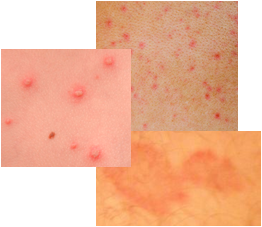Xanthoma
Visit this
PICTURES OF RASHES PAGE
Xanthoma, which is also known as xanthelasma, is a skin condition characterized by fatty skin growths or bumps. These growths are due to fat or lipid build-up under the surface of the skin. The growths are almost always painless and are not cancerous. They can be very small or rather large and up to three inches or 7.5 cm in size. They are common in older adults or those with a high content of blood lipids, although in some cases the cause of the appearance of these fatty skin growths is not fully understood or known.
Types of Xanthoma
There are various types of this skin problem, differentiated by where they occur on the body.
Palpebrum is the most comment variant of this skin problem. The growths occur in a symmetrical fashion on the lower and upper eyelids and are velvety soft, yellow, and flat papules. Tuberous are described as red-yellow firm and painless growths. They are found on the knees, elbows, heals, and buttocks – essentially the common skin pressure points on the body. Tendinous are commonly found on the backs of the hands and feet, and on the Achilles tendons. They are free movable papules or bumps. Eruptive Xanthomas are found on the arms, legs, shoulders, and buttocks skin areas. It is also not unusual for the small yellow, red-yellow, or yellowish orange bumps to appear on any other area of the body. In this case, the growths may be itchy and have some degree of tenderness. ThePlane version of this fatty skin growth problem occurs anywhere on the body and the skin bumps are soft, flat or patchy and are yellowish, tannish, or dark red in color. Diffuse Plane Xanthomatosis appears as large flat reddish-yellow plaques that are found over the face, neck, buttocks, chest, and in the skin folds areas. Finally, Xanthoma Disseminatum consists of hundreds of small reddish-brown or yellowish-brown skin bumps found on the face and trunk. It is not unusual for these bumps to concentrate in the armpit or groin areas and to join together and form a patch of affected skin.
As for many other skin conditions, an examination of the symptoms and the possible use of a skin biopsy that will look for fatty or lipid deposits will likely be used by a physician to diagnose Xanthelasma.
Because this skin condition is an indication that there may be an underlying health problem, it is a good idea to visit a physician. Diabetes, inherited lipid metabolic disorders, and certain cancers can lead to a higher blood lipid level that can manifest itself as this skin rash or fatty skin bumps.
Treatments
A treatment may be desired for cosmetic reasons. One possible treatment is to address the underlying medical condition, primarily by reducing the lipid content in the blood. By lowering blood lipids, triglycerides and cholesterol, through diet, exercise, and possibly medications, the development of this skin condition may be reduced. Alternatively, the fatty skin growths may be removed with minor excision surgery, electrodessication, laser vaporisation, or the use of topical trichloroacetic acid to essentially chemically burn the xanthelasma off the skin.
skin care | diagnose my skin rash | strep rash | syphilis rash | lyme disease rash | ringworm skin rash | tinea pedis foot rash | tinea versicolor skin discoloration rash | lupus rash | shingles rash | chicken pox rash | hiv rash | stress rash | heat rash | dry skin rash | scabies rash | bug bites or insect bites or stings | poison ivy rash | food allergy rash | swimming pool rash | penicillin rash | lamictal rash | nair rash | niacin skin rash | foot rash | roseola rash | underarm rash | hot tub rash | shaving rash | body rash | allergic rash | granuloma annulare rash | lichen planus | xanthoma | common rashes
